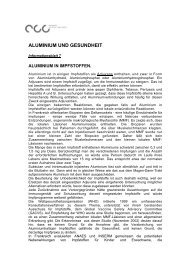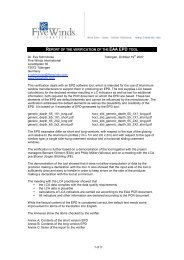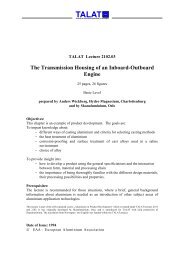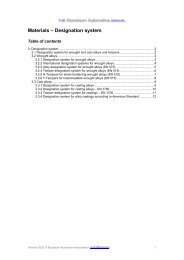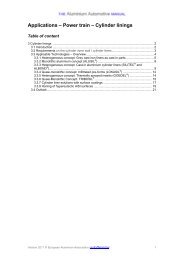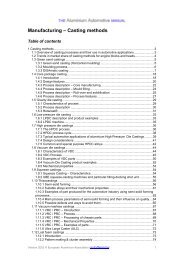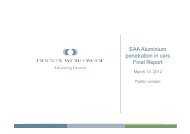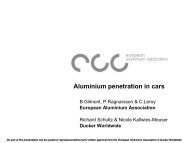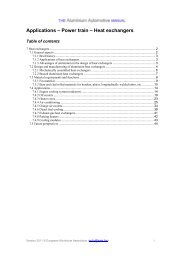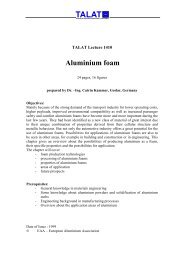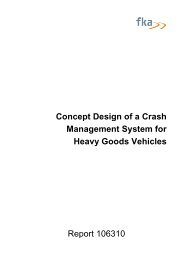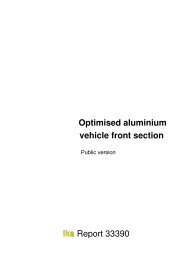aluminium in commercial vehicles - European Aluminium Association
aluminium in commercial vehicles - European Aluminium Association
aluminium in commercial vehicles - European Aluminium Association
Create successful ePaper yourself
Turn your PDF publications into a flip-book with our unique Google optimized e-Paper software.
58 EUROPEAN ALUMINIUM ASSOCIATION ALUMINIUM IN COMMERCIAL VEHICLES CHAPTER VI<br />
1. Introduction<br />
The new <strong>European</strong> design code<br />
for <strong>alum<strong>in</strong>ium</strong> structures is used<br />
as a basis for this chapter. The<br />
name of this standard is:<br />
EN 1999 Eurocode 9: Design of<br />
<strong>alum<strong>in</strong>ium</strong> structure<br />
Part 1-1 General structural rules<br />
Part 1-2 Structural fire design<br />
Part 1-3 Structures susceptible to<br />
fatigue<br />
Part 1-4 Cold-formed structural<br />
sheet<strong>in</strong>g<br />
Part 1-5 Shell structures<br />
Part 1-1 is used for all static<br />
design and Part 1-3 for all<br />
fatigue design shown <strong>in</strong> this<br />
chapter.<br />
A new <strong>European</strong> standard for the<br />
execution of structural <strong>alum<strong>in</strong>ium</strong><br />
is under development and is<br />
soon ready for publication. It is<br />
recommended to use relevant<br />
parts of this standard for execution<br />
of <strong>alum<strong>in</strong>ium</strong> components<br />
for use <strong>in</strong> <strong>commercial</strong> <strong>vehicles</strong>.<br />
The name of this standard is:<br />
EN 1090-3: Execution of steel<br />
structures and <strong>alum<strong>in</strong>ium</strong> structures<br />
– Part 3: Technical requirements<br />
for <strong>alum<strong>in</strong>ium</strong> structures<br />
2. Possibilities<br />
with <strong>alum<strong>in</strong>ium</strong><br />
The advantages of design<strong>in</strong>g<br />
with <strong>alum<strong>in</strong>ium</strong> are:<br />
• High strength-to-weight ratio<br />
• Possibilities to create your own<br />
cross-sections with the extrusion<br />
technique<br />
• Good corrosion resistance<br />
• Long vehicle life<br />
• Easy to work with<br />
• Easy to repair<br />
Especially for product design, the<br />
use of tailor-made profiles is a<br />
great advantage for <strong>alum<strong>in</strong>ium</strong><br />
compared with other metals. In<br />
profile design the material can be<br />
placed where the effect of the<br />
material is optimal regard<strong>in</strong>g<br />
resistance. Details can be made<br />
<strong>in</strong> such a way that it will ease the<br />
fabrication and assembl<strong>in</strong>g of<br />
the components.<br />
3. Symbols<br />
Frequently used symbols are<br />
def<strong>in</strong>ed <strong>in</strong> this section:<br />
f characteristic value of 0.2 %<br />
o<br />
proof strength<br />
f characteristic value of ulti-<br />
u<br />
mate tensile strength<br />
f characteristic ultimate tensile<br />
ub<br />
strength of bolt<br />
E modulus of elasticity<br />
d bolt diameter<br />
d hole diameter<br />
o<br />
t wall thickness<br />
A cross section area<br />
W section modulus<br />
γ partial safety factor for resist-<br />
M<br />
ance (see the def<strong>in</strong>itions <strong>in</strong> section<br />
5.2), <strong>in</strong> EN 1999-1-1:<br />
Subscript is used for factored<br />
Ed<br />
load effects. It may be on axial<br />
force (N ), bend<strong>in</strong>g moment<br />
Ed<br />
(M ), shear force (V ), torsion<br />
Ed Ed<br />
(T ) and forces <strong>in</strong> connection<br />
Ed<br />
with bolted connections (F for v,Ed<br />
shear force and F for tension<br />
t,Ed<br />
force).



